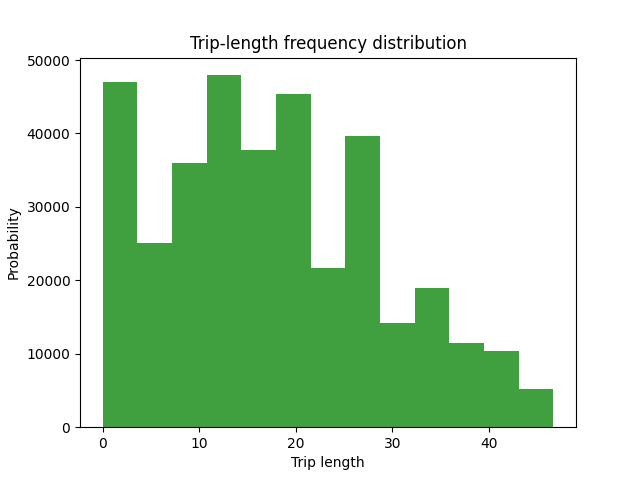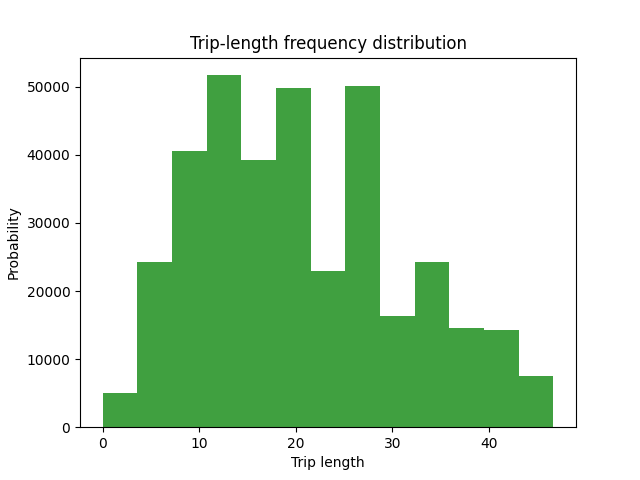Note
Go to the end to download the full example code.
Trip Distribution#
In this example, we calibrate a Synthetic Gravity Model that same model plus IPF (Fratar/Furness).
# Imports
from uuid import uuid4
from tempfile import gettempdir
from os.path import join
from aequilibrae.utils.create_example import create_example
import pandas as pd
import numpy as np
We create the example project inside our temp folder
fldr = join(gettempdir(), uuid4().hex)
project = create_example(fldr)
We get the demand matrix directly from the project record so let’s inspect what we have in the project
proj_matrices = project.matrices
print(proj_matrices.list())
name file_name ... description status
0 demand_omx demand.omx ... Original data imported to OMX format
1 demand_mc demand_mc.omx ... None
2 skims skims.omx ... Example skim
3 demand_aem demand.aem ... Original data imported to AEM format
[4 rows x 8 columns]
We get the demand matrix
demand = proj_matrices.get_matrix("demand_omx")
demand.computational_view(["matrix"])
And the impedance
impedance = proj_matrices.get_matrix("skims")
impedance.computational_view(["time_final"])
Let’s have a function to plot the Trip Length Frequency Distribution
from math import log10, floor
import matplotlib.pyplot as plt
def plot_tlfd(demand, skim, name):
plt.clf()
b = floor(log10(skim.shape[0]) * 10)
n, bins, patches = plt.hist(
np.nan_to_num(skim.flatten(), 0),
bins=b,
weights=np.nan_to_num(demand.flatten()),
density=False,
facecolor="g",
alpha=0.75,
)
plt.xlabel("Trip length")
plt.ylabel("Probability")
plt.title("Trip-length frequency distribution")
plt.savefig(name, format="png")
return plt
from aequilibrae.distribution import GravityCalibration
for function in ["power", "expo"]:
gc = GravityCalibration(matrix=demand, impedance=impedance, function=function, nan_as_zero=True)
gc.calibrate()
model = gc.model
# We save the model
model.save(join(fldr, f"{function}_model.mod"))
# We can save an image for the resulting model
_ = plot_tlfd(gc.result_matrix.matrix_view, impedance.matrix_view, join(fldr, f"{function}_tfld.png"))
# We can save the result of applying the model as well
# We can also save the calibration report
with open(join(fldr, f"{function}_convergence.log"), "w") as otp:
for r in gc.report:
otp.write(r + "\n")

/opt/hostedtoolcache/Python/3.10.14/x64/lib/python3.10/site-packages/aequilibrae/distribution/gravity_application.py:321: RuntimeWarning: divide by zero encountered in power
self.output.matrix_view[i, :] = (np.power(self.impedance.matrix_view[i, :], -self.model.alpha) * p * a)[
/opt/hostedtoolcache/Python/3.10.14/x64/lib/python3.10/site-packages/aequilibrae/distribution/gravity_application.py:335: RuntimeWarning: invalid value encountered in multiply
self.output.matrix_view[:, :] = self.output.matrix_view[:, :] * non_inf
We save a trip length frequency distribution for the demand itself
plt = plot_tlfd(demand.matrix_view, impedance.matrix_view, join(fldr, "demand_tfld.png"))
plt.show()

Forecast#
We create a set of ‘future’ vectors by applying some models and apply the model for both deterrence functions
from aequilibrae.distribution import Ipf, GravityApplication, SyntheticGravityModel
from aequilibrae.matrix import AequilibraeData
import numpy as np
zonal_data = pd.read_sql("Select zone_id, population, employment from zones order by zone_id", project.conn)
We compute the vectors from our matrix
args = {
"file_path": join(fldr, "synthetic_future_vector.aed"),
"entries": demand.zones,
"field_names": ["origins", "destinations"],
"data_types": [np.float64, np.float64],
"memory_mode": True,
}
vectors = AequilibraeData()
vectors.create_empty(**args)
vectors.index[:] = zonal_data.zone_id[:]
# We apply a trivial regression-based model and balance the vectors
vectors.origins[:] = zonal_data.population[:] * 2.32
vectors.destinations[:] = zonal_data.employment[:] * 1.87
vectors.destinations *= vectors.origins.sum() / vectors.destinations.sum()
We simply apply the models to the same impedance matrix now
for function in ["power", "expo"]:
model = SyntheticGravityModel()
model.load(join(fldr, f"{function}_model.mod"))
outmatrix = join(proj_matrices.fldr, f"demand_{function}_model.aem")
args = {
"impedance": impedance,
"rows": vectors,
"row_field": "origins",
"model": model,
"columns": vectors,
"column_field": "destinations",
"nan_as_zero": True,
}
gravity = GravityApplication(**args)
gravity.apply()
# We get the output matrix and save it to OMX too,
gravity.save_to_project(name=f"demand_{function}_model_omx", file_name=f"demand_{function}_model.omx")
We update the matrices table/records and verify that the new matrices are indeed there
proj_matrices.update_database()
print(proj_matrices.list())
name ... status
0 demand_omx ...
1 demand_mc ...
2 skims ...
3 demand_aem ...
4 demand_power_model_omx ...
5 demand_expo_model_omx ...
[6 rows x 8 columns]
We now run IPF for the future vectors
args = {
"matrix": demand,
"rows": vectors,
"columns": vectors,
"column_field": "destinations",
"row_field": "origins",
"nan_as_zero": True,
}
ipf = Ipf(**args)
ipf.fit()
ipf.save_to_project(name="demand_ipf", file_name="demand_ipf.aem")
ipf.save_to_project(name="demand_ipf_omx", file_name="demand_ipf.omx")
<aequilibrae.project.data.matrix_record.MatrixRecord object at 0x7fa9072f0b80>
print(proj_matrices.list())
name ... status
0 demand_omx ...
1 demand_mc ...
2 skims ...
3 demand_aem ...
4 demand_power_model_omx ...
5 demand_expo_model_omx ...
6 demand_ipf ...
7 demand_ipf_omx ...
[8 rows x 8 columns]
project.close()
Total running time of the script: (0 minutes 1.388 seconds)